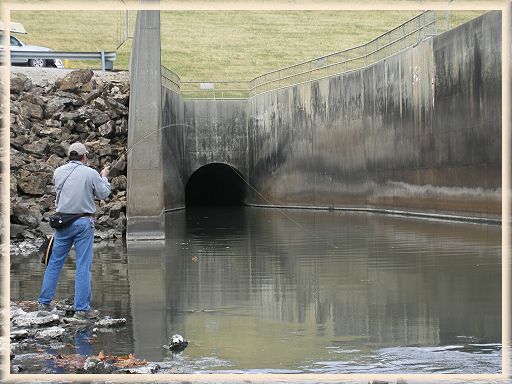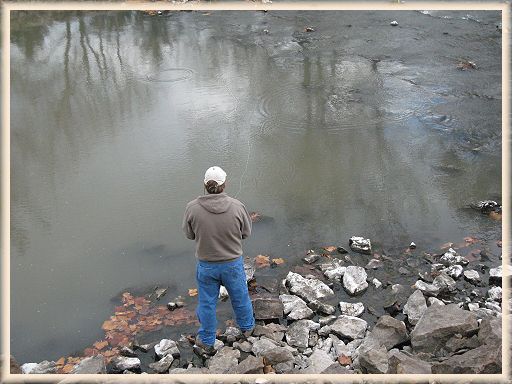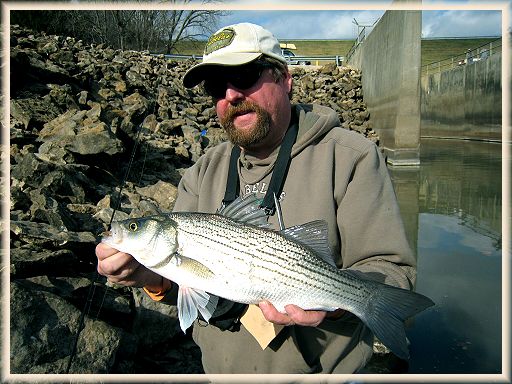|
The window I'd cracked open the night before was letting in some
great-feeling cool morning air. I could have laid there dozing
another hour, maybe two hours, but suddenly sat up with a start,
trying to remember something.
Was it four days ago I checked the Kansas City District Corps of
Engineers Lake Forecast web site to ascertain outflows and
projected outflows at some of my area's federal lakes? One lake
relatively close reservoir, Pomona Lake, was releasing 250 cubic
feet per second (cfs) but the lake forecast said that three days
hence its volume would be cut to 100 cfs.
"Three days hence" was...today! And it's dawn and what am I doing
in bed? Throw on some rags, hop in the pickup, get down to Pomona
and try that outlet pool! Get movin', boy!
An hour later I parked next to the outlet conduit. Two fishermen
were already there, both devotees of the angling technique most
often seen at this outlet: you reach over the stout chain link
fence mounted atop the outlet chute's concrete wall, lower a
baited hook and heavy sinker straight down 20 feet into the
stilling basin then stand there waiting for a bite.
Neither of these fine gentlemen would be snagging me with false casts
propelled by a Spey rod. They in turn had no cause to fear getting
snagged in the ear by one of my false casts, as I was intent on
fishing the large pool 40 yards downstream from their concrete-walled
"wishing well."
At Pomona Lake's outlet a man-made riffle separates the stilling
basin from the pool I would be fishing. The pool below this riffle
is where one morning this spring I caught and released 125 small
crappies.
The federal dams in Kansas generally aren't opened for large volume
releases unless the lake's watershed has received heavy rain or snow
melt runoff during the preceding weeks. Heavy surface runoff carries
lots of sediment into the lakes, making the water turbid. The water
at Pomona outlet today was quite dingy. Nothing startling about this
and I was unconcerned because on many previous trips here I'd caught
fish despite this handicap.
I began working an eddy below the riffle and in short order a crappie
fell prey to my best good buddy – "Old Reliable," a #10 flashback
Hare's Ear Nymph. Ahh...this was going to be a good trip and I was
ready for one. In my pickup's bed sat a Styrofoam cooler containing
a bag of ice meant for keeping fish cold and fresh during the drive
home. I'd also brought a floating fish basket with which to keep alive
the crappies I caught until such time as it became necessary to tote
my haul up to the pickup and place them under ice.
Meat fishing; yes, I was meat fishing, hoping to load up on great-tasting
crappie fillets. Catching one so quickly therefore had me feeling excited.
Thirty minutes later I was still somewhat excited but becoming confused:
not another fish of any kind had touched Old Reliable. Then I snagged
the bottom and had to break him off.
Since I was trying for crappies only and the recent 250-cfs release
had doubtless flushed many crappies from the lake's main body into
this pool, some of those recent arrivals had to still be holding here.
I looked inside my fly box for a pattern specifically designed for
catching crappies. There it was: a Crappie Candy. (My success in
making conceptual links such as this often zip past me, not coming
to mind until long after I've left the water.)
On its first presentation, an actual crappie grabbed the crappie fly
called Crappie Candy. What a deal; I'd connected the dots! My excitement
level came rushing back. Then twenty minutes ticked away without another
touch and confusion took excitement's place. I was debating whether to
switch flies again when the rock-lined bottom of the outlet pool decided
the matter for me by grabbing Candy at a depth and distance from shore
that kept me from wiggling it free. I had to break off the fly.
Okay, what next? Let's see: there's a #12 Skip Morris Panfish that's
been in my box for ages. It's mostly red in color and I hardly ever
use red flies, but...why not? Into the pool it flew. Two freshwater
drums, a channel catfish "fiddler" and a crappie liked it. Then
another rock grabbed hold, wouldn't let go and I had to break off
Skip Morris, too.
On went a #10 beadhead Olive Woolly Bugger with red marabou tail.
By now I'd worked my way far down the right bank. Two crappies
fell prey to the Bugger, both hookups happening close against the
rocky shoreline. Then the action fizzled. This might be one of
those days where a person is lucky to catch one or two fish per
pattern used. I methodically backtracked to the riffle where I'd
started from, catching nothing on the way back. But at least I
didn't lost the Bugger and by now that felt like a minor triumph.
My eyes were sore from squinting into surface glare (I'd forgotten
to bring my polarized clip-ons). I was hungry from skipping breakfast
and I was thirsty. It was 11AM, long past time to skedaddle from this
slow-action place. But then I looked at the stilling basin upstream
of the riffle, at deeper water I hadn't thrown a single cast into all
morning and shrugged, "Why not? I'm here."
I crept to a spot on the rocks twenty feet above the riffle and sent
a cast straight out. My intention was to let the Woolly Bugger sink
for a few seconds and then retrieve it more or less parallel to the
riffle's upstream zone where water is just beginning to enter the rocks?
Each cast thus thrown would take a curving course back toward me due
to the cross-current. By manipulating the speed of my retrieves,
changing the number of sink-seconds I gave each Woolly Bugger after
splashdown and by landing the Bugger closer to or farther from the
riffle I could methodically explore almost the entire linear zone
along the riffle's head.
This business of systematically probing the head of a riffle is nothing
I dreamed up. It's a tactic I saw demonstrated some years ago during
an episode of In-Fisherman on TV. That broadcast stuck in my
mind, stuck to the point where during canoe trips on Missouri's Current
River I made it a habit, whenever approaching a riffle or rapid, to
peer down through the clear water and observe the aquatic environment
passing below.
Sure enough: fish do congregate at the heads of riffles. They do
it because the rising riverbed compresses the habitat through which
approaching prey items must swim. The confined area makes it easier
for predators to spot and grab prey.
Fine, but right now I'm not fishing the Current River or any other
beautiful clear water stream. This is the stilling basin of a muddy
Kansas lake and I'm tossing a fly of muted color into stained water
above a man-made riffle. Picture postcard material this place ain't,
but it does let me practice head-of-riffle angling in case I'm ever
in southeast Missouri or northern Arkansas trying for...
My Woolly Bugger dimpled the water, drifted five feet toward the
riffle and got pulverized by a fish that zoomed upstream so fast
I thought it was might swim through the outlet's conduit pipe and
escape back into the lake.

A few minutes later I led the fish into the rocks at my feet,
grabbed its lower jaw and lifted it for identification. Two
small rough patches arranged side-by-side on its tongue make
it a wiper (white bass/striped bass hybrid). Well, I'll be!
After releasing it I cast back into the same general area, maybe
ten feet closer to where I was standing. I let the Woolly Bugger
sink a couple of seconds then began another retrieve. Crunch!
Another hard hit followed by another wiper brought to hand after
some difficulty.
What's going on here? Hey, this is cool!
A double-haul cast airmailed the Bugger three-quarters of the way
across the stilling basin. Not by aim but accident it landed much
closer to the riffle's front, where the shallowing bottom was causing
the squeezed current to pick up speed. The Bugger had barely hit
the water when a swirl appeared and it was violently inhaled by
what turned out to be yet another wiper!
At this third hard strike I involuntarily let out a loud whoop.
I began visualizing a row of wipers spaced along the riffle's
leading edge like defensive linemen at a football game's line
of scrimmage, each fish hunkered down facing into the current
on hair trigger alert for prey sneaking through into the pool
below, each wiper motivated by predatory instinct to uphold the
defensive lineman's creed: "They Shall Not Pass."
Until now I'd ignored the water closest to me, always casting
farther out. The untried water was structurally identical to
what I'd just caught three fish out of. Why was I avoiding it?
I don't know; why do we always overlook the water close to our
shoes? No "casting drama" maybe? Trying it would involve throwing
the Bugger all of twenty feet – essentially my rod's 9-foot length
plus the tapered leader and some change. Boring but, oh, alright...
I let the OWB settle out of sight. It was drifting toward the
riffle on a gradual up-angle rise when Thunder Fin took note and
attacked with extreme prejudice. If this wasn't the stilling basin's
Alpha wiper I'll eat your hat. He fought harder than the first three
wipers combined, running me around the stilling basin like I was a
puppy on a leash before punching my ticket in a most humbling fashion.
At my feet was a triangle of large rocks that formed a "harbor" into
which I'd led the first three wipers before lipping and unhooking them.
Beside these three rocks floated my fish basket with four crappies
inside. The basket's nylon cord was not connected to anything; I'd
simply swung the basket into the pool then draped the cord across some
rocks. No need to secure the cord because an eddy current was pushing
the basket firmly against the bank.
When he finally showed signs of being whipped, I gave Thunder Fin a
steady pull and slid him into Catch and Release Harbor. He entered
innocently enough but suddenly zipped around one of the three rocks
and bolted for the open, in the process swimming under my fish basket's
cord so fast that the cord twirled itself around my leader. The result
being, Thunder Fin was now towing my fish basket behind him.
Not wanting to lose those four crappies, I quickly bent down to rescue
the fish basket. This sudden move triggered a painful cramp in my left
ribcage. As I was trying to relax the cramp my leader pulled free of the
fish basket's cord. Then, instead of racing away into the stilling basin's
depths, the fish turned hard right and charged into the riffle, swimming so
fast he literally ran aground and flopped onto his side.
I was forced to choose between saving the fish basket (now beginning
to drift downriver), or hobbling over to pounce on Thunder Fin before
he could get his wits about him. I opted for the fish basket. It was
risky reaching for it because the bank here drops away sharply. I had
on street shoes and if I slipped on these wet rocks I could fall into
the stilling basin.
Extending my left arm as far as I could, my fingertips just barely touched
the fish basket's wire handle. I leaned out a little farther, slipped on a
wet rock and fell into the stilling basin.
Cursing and dragging the fish basket ashore, I rudely dropped it on
the rocks and turned my wrath downriver. The rib cramp was still
hurting and I didn't exactly appreciate this recalcitrant wiper
making me look like a fire-hosed circus clown.
And of course, no sooner did I lay down my fly rod and stand to go
fetch him than Thunder Fin wiggled down between two rocks and found
barely enough water depth to offer traction. Before I could reach
him, with a head shake he dislodged the barbless Woolly Bugger. Then
a second vigorous spasm propelled him back into the stilling basin.
It happened fast but I think he flipped the middle spine in his dorsal
fin at me as he rocketed past.
I interpreted this fiasco as a sign that it was time to call it a day.
I held the fish basket out over the water, pushed inward on its lower
trapdoor and shook out the four crappies. One by one they splashed
into the stilling basin, lingered a few moments then turned for the
depths and swam home. I climbed the rocks, got in my pickup and
drove home. Everybody went home.
THREE WEEKS LATER I returned, this time with backup. The second
visit happened because Spring Hill, KS fly angler Tim Giger invited
me to try for white bass with him at another reservoir, Melvern Lake,
not far south of Pomona. At Melvern that morning Tim and I dealt with
high wind from the south – a wind that created good conditions for white
bass fishing off the north shore but at the cost of grinding us down
physically from our struggles casting into it.
When time came to leave Melvern Lake I suggested a highway route that
would take us past the aforementioned Pomona Lake. Pomona dam's outlet
is bordered closely on the south by a tall hill that might shield us
from the wind.
We slowed on approaching the outlet's parking area. From the roadway
I glanced down over the guardrail in time to see something totally
unexpected: a few feet upstream of the riffle a fish had just swirled
to the top, leaving an expanding concentric ring smack dab in the zone
where I'd caught those four wipers three weeks earlier.
Surely those wipers aren't still here, I thought. Or maybe they are?
I would leave it to Tim to find out. He'd already told me that he has
fished this place before, so when I clued him to the rise that I'd seen
he knew just what to do and how to do it.

Tim worked the riffle's up-zone using a Gummy Minnow, a most interesting
streamer pattern due to its virtually transparent rubber body. After
only a few casts, something big and mean decided it wanted Gummy in
its tummy. Weakened finally after running a number of hot laps around
the stilling basin perimeter, the fish surrendered and got lifted for a
mug shot.
Results from the finprints we inked aren't back yet from the FBI
so I can't claim a positive identification; still, I'm 99% certain
the fish Tim is holding below is none other than Thunder Fin.

I felt vindicated seeing this ferocious beast briefly held up in
the air. And I felt better yet watching Tim cut him loose with
just a warning ticket. Thunder Fin is right back out there on
the battle line, him and his speed demon buddies. (Tim caught
and released the other three, too!) Their attitude is bad.
Real bad. But they work their territory, we work ours and
maybe we'll all meet up again. ~ Joe
About Joe:
 From Douglas County, Kansas, Joe is a former municipal and
federal police officer, now retired. In addition to fishing, he hunts
upland birds and waterfowl, and for the last 15 years
has pursued the sport of solo canoeing. On the nearby
Kansas River he has now logged nearly 5,000 river miles
while doing some 400 wilderness style canoe camping
trips. A musician/singer/songwriter as well, Joe recently
retired from the U.S. General Services Adminstration.
From Douglas County, Kansas, Joe is a former municipal and
federal police officer, now retired. In addition to fishing, he hunts
upland birds and waterfowl, and for the last 15 years
has pursued the sport of solo canoeing. On the nearby
Kansas River he has now logged nearly 5,000 river miles
while doing some 400 wilderness style canoe camping
trips. A musician/singer/songwriter as well, Joe recently
retired from the U.S. General Services Adminstration.
Joe at one time was a freelance photojournalist who wrote the
Sunday Outdoors column for his city newspaper. Outdoor
sports, writing and music have never earned him any money,
but remain priceless activities essential to surviving the
former 'day job.'
|




 From Douglas County, Kansas, Joe is a former municipal and
federal police officer, now retired. In addition to fishing, he hunts
upland birds and waterfowl, and for the last 15 years
has pursued the sport of solo canoeing. On the nearby
Kansas River he has now logged nearly 5,000 river miles
while doing some 400 wilderness style canoe camping
trips. A musician/singer/songwriter as well, Joe recently
retired from the U.S. General Services Adminstration.
From Douglas County, Kansas, Joe is a former municipal and
federal police officer, now retired. In addition to fishing, he hunts
upland birds and waterfowl, and for the last 15 years
has pursued the sport of solo canoeing. On the nearby
Kansas River he has now logged nearly 5,000 river miles
while doing some 400 wilderness style canoe camping
trips. A musician/singer/songwriter as well, Joe recently
retired from the U.S. General Services Adminstration.